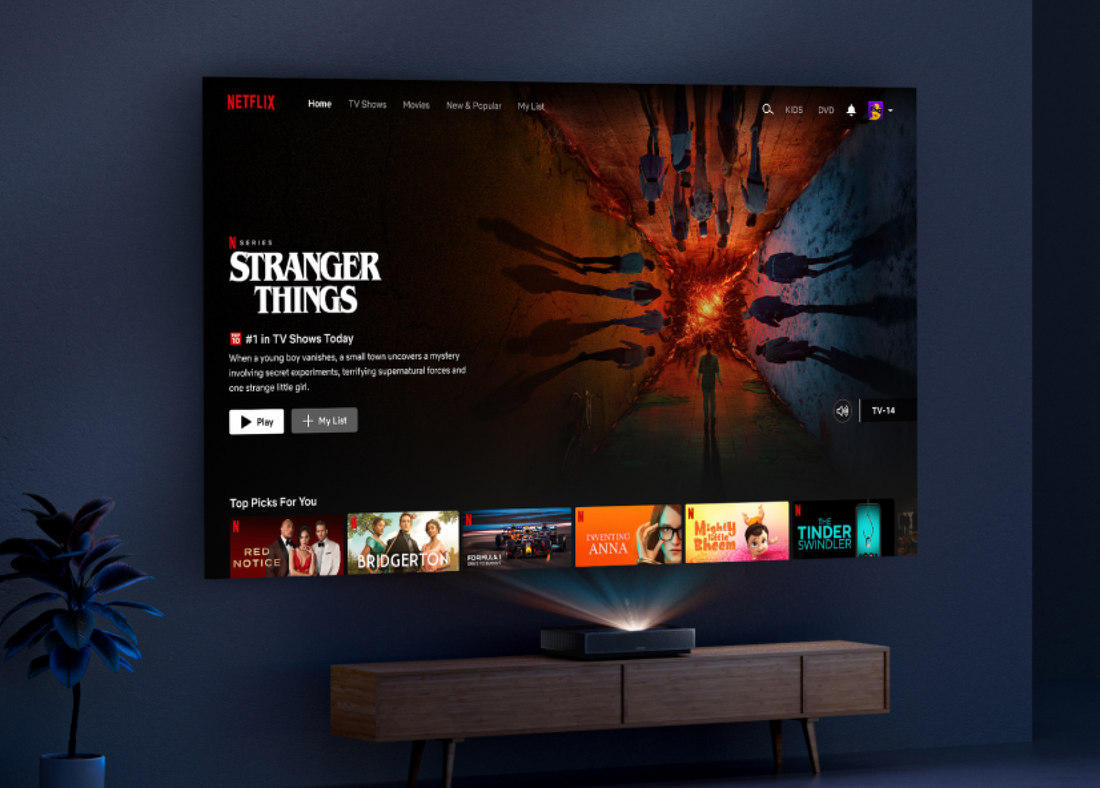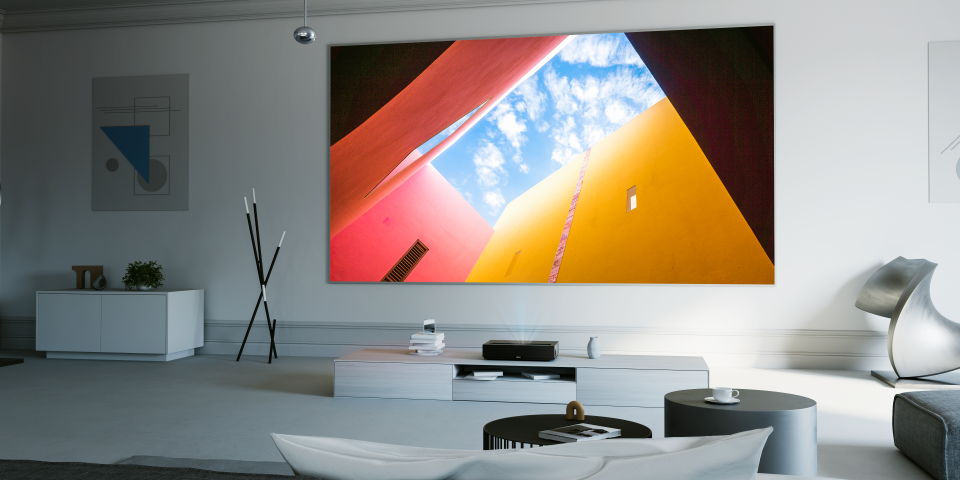Why Choose a Laser Projector?

Choosing the right projector for your home theater can seem like a daunting decision. You’re often left wondering what kind of projector is going to give you the best viewing experience and bring the movie magic to your living room. That’s where laser projectors come in.
Laser projectors are rapidly gaining popularity, becoming the go-to choice for anyone seeking high-quality projection technology. Whether for home theaters, business presentations, or educational settings, laser projectors offer a host of benefits that set them apart from traditional lamp-based projectors. Here’s a comprehensive look at why laser projectors should be your top choice.
Laser Projectors Are Leading the Market
The laser projector market is experiencing significant growth, with its size valued at $6.55 billion in 2023 and expected to reach $26.72 billion by 2032, growing at a robust compound annual growth rate (CAGR) of 16.63% from 2024 to 2032. This surge is driven by the expanding use of laser projection technology across various industries, thanks to its numerous advantages over traditional lamp-based projectors, including lower maintenance costs, longer lifespan, and superior image quality. As businesses and consumers increasingly opt for laser projectors in settings like meeting spaces, theaters, and even medical applications, the market is set to continue its rapid expansion.
Laser projectors are making waves across multiple sectors, including commercial, military, and medical fields, due to their high-resolution capabilities and adaptability. In the medical industry, they are used to display high-quality, detailed images during surgeries, while in the defense sector, they facilitate advanced geographic mapping with precise visuals over longer distances. The commercial sector is also seeing increased adoption of laser projectors for their reliability and cost-effectiveness, further fueled by the growing popularity of high-quality cinematic experiences such as IMAX.
Regionally, the Asia-Pacific area leads the market, driven by the widespread adoption of laser projectors in public spaces like stadiums and amusement parks, alongside advancements in 4K and 8K projection technologies. Europe follows closely, supported by the integration of laser projectors in various industries and the presence of major manufacturers like Barco and Hitachi. North America is expected to grow at the fastest rate, fueled by increasing consumer awareness and adoption of high-brightness laser projectors in educational and professional settings, as well as continuous technological advancements in the field.
Understanding Light and Projectors
The two key components of any projector are the imaging technology of the projector as well as the light source. To make sense of your light source options—whether it's a lamp, laser, or LED—you need to understand how these imaging technologies work. All color displays, including projectors, use the principle of additive color, where three primary colors—red, green, and blue—are mixed to produce all other colors. Projectors with three imaging chips display these colors simultaneously, integrating them over space, while single-chip projectors show them sequentially over time. This sequential method can sometimes cause rainbow artifacts, which are more noticeable in lamp-based projectors than in laser or LED projectors.
When it comes to light sources, lamps are the traditional choice but are increasingly outclassed by solid-state options like LEDs and lasers. Lamps are usually cheaper upfront but have shorter lifespans, typically lasting between 2,000 to 10,000 hours, and lose brightness quickly, making them less cost-effective in the long run for heavy use. In contrast, LEDs and lasers boast lifespans of 20,000 to 30,000 hours or more, maintaining brightness more consistently. Lasers, in particular, stand out for their ability to deliver higher brightness and good color accuracy even at their brightest settings, making them ideal for environments with ambient light.
Ultimately, choosing the right light source depends on your needs. Lamp-based projectors are an option if you don’t need to use the projector often. LEDs are popular in smaller, portable projectors, though they often struggle with brightness and color accuracy compared to lasers. Lasers, however, offer the best balance of brightness, color accuracy, and long-term value, making them increasingly the go-to choice. As the technology continues to evolve, lasers are poised to dominate the projector market, as we’ve explored above.
Bring Home the Big Screen Feeling
One of the standout features of laser projectors is their ability to deliver large, bright, and sharp images. Laser projectors excel in creating immersive, big-screen experiences that traditional projectors struggle to match. An example of this is the Formoive Cinema Edge, offering an ultra-short throw (UST) ratio of 0.23:1. This means that you only need 49 cm (about 19 inches) of space to project a massive 150-inch screen. This incredible capability allows even the smallest rooms to become immersive entertainment spaces.
A Feast for the Eyes
When it comes to image quality, laser projectors are a clear winner. Thanks to cutting-edge technologies like ALPD (Advanced Laser Phosphor Display) by Appotronics, laser projectors offer a level of visual excellence that sets them apart. ALPD technology, used in the Formovie Cinema Edge, enhances image brightness, sharpness, and color accuracy.
Laser projectors also offer superior image quality through 4K resolution, allowing you to enjoy ultra-high-definition visuals with exceptional detail and clarity. This makes a laser projector perfect for movies, sports, and gaming. Additionally, laser projectors deliver deep blacks and vibrant colors, enhancing the overall viewing experience with richer, more dynamic images. Laser projectors are also able to reproduce a broader spectrum of colors, making images look more vivid and lifelike, as highlighted by Projector Central.
Low Maintenance
Compared to traditional projectors, laser projectors require significantly less maintenance. They have a longer lifespan, often lasting up to 20,000 to 30,000 hours without needing lamp replacements. Laser projectors also run cooler and more efficiently, reducing the need for frequent maintenance and lowering energy costs. Lastly, unlike traditional bulbs that degrade over time, lasers maintain brightness and color accuracy throughout their lifespan.
What Laser Projector Users Are Saying
The reviews for laser projectors are positive and it seems that laser projectors are only going to continue rising in popularity thanks to their superior image quality as well as an overall immersive experience that truly does bring you closer to your favorite moments.
The AV Forums review of the Formovie Theater praises the projector and affirms that the projector’s triple-color laser light source means you’ll get consistent light output over the lifetime of the unit as well as the Theater offering decent brightness for varied use cases.
Another review of laser projectors focused on the color and crispness of the images that laser projectors are able to produce as well as the cost-savings over time when choosing a laser projector rather than a traditional lamp projector.
Overall, investing in a laser projector for your home theater setup represents a forward-thinking choice that aligns with market trends and technological advancements, providing superior image quality, ease of use, and long-term value.
The Home Theater Choice
Laser projectors represent a leap forward in projection technology, offering superior image quality, low maintenance, and the ability to deliver impressive big-screen experiences. Whether you’re upgrading your home theater or looking to buy your first UST projector, laser projectors are on an upward tick, and show no sign of slowing down in their advancements.
Choose a laser projector and enjoy a better, brighter, and more reliable viewing experience. Get your hands on the newest from Formovie, the Cinema Edge, an ALDP projector that promises to make movies more memorable.
